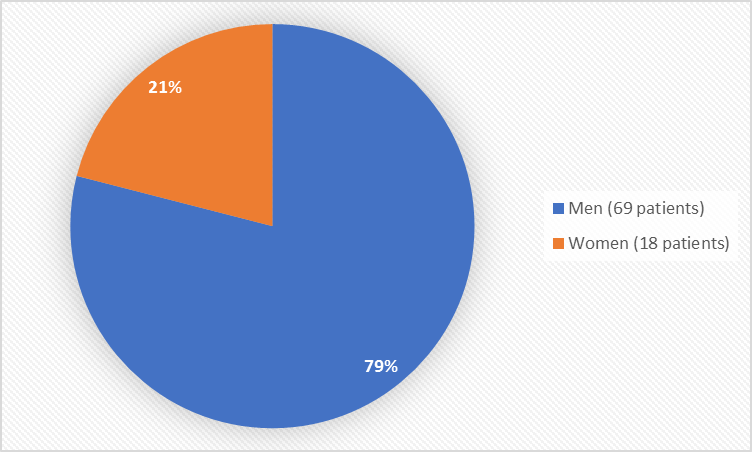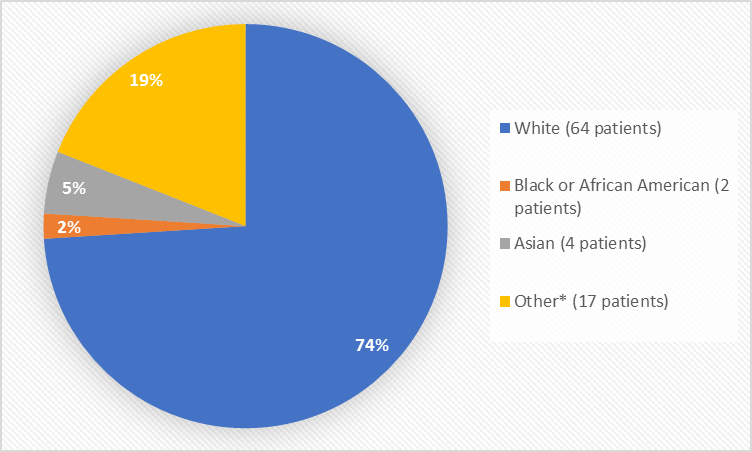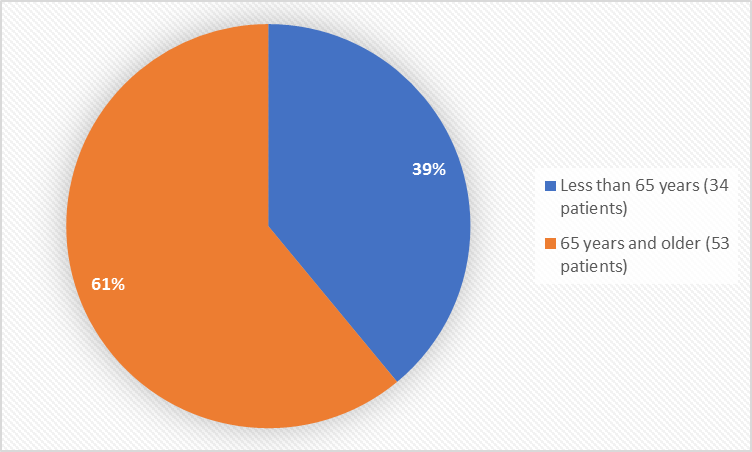Drug Trials Snapshots: BALVERSA
HOW TO USE THIS SNAPSHOT
The information provided in Snapshots highlights who participated in the clinical trials that supported the FDA approval of this drug, and whether there were differences among sex, race and age groups. The “MORE INFO” bar shows more detailed, technical content for each section. The Snapshot is intended as one tool for consumers to use when discussing the risks and benefits of the drugs.
LIMITATIONS OF THIS SNAPSHOT:
Do not rely on Snapshots to make decisions regarding medical care. Always speak to your health provider about the risks and benefits of a drug. Refer to the BALVERSA Package Insert for complete information.
BALVERSA (erdafitinib)
bal-VER-sah
Janssen Products, LP
Approval date: April 12, 2019
DRUG TRIALS SNAPSHOT SUMMARY:
What is the drug for?
BALVERSA is a drug for the treatment of a type of bladder and urinary tract cancer called urothelial carcinoma. BALVERSA may be used in patients with urothelial carcinoma:
- whose tumors have a certain type of abnormal (FGFR) gene and
- whose cancer has spread (locally advanced or metastatic urothelial carcinoma) and
- when chemotherapy that contains platinum did not work or is no longer working.
How is this drug used?
BALVERSA is a tablet taken once a day for a total dose of 8 mg. During treatment, the BALVERSA dose may be increased to 9 mg if needed.
What are the benefits of this drug?
Thirty-two percent of 87 patients who received BALVERSA experienced complete or partial shrinkage of their tumors.
BALVERSA was approved under FDA’s accelerated approval program, which provides earlier patient access to a promising new drug while the company continues to conduct clinical trials to confirm that the drug works well.
What are the benefits of this drug (results of trials used to assess efficacy)?
The table below summarizes efficacy results for the clinical trials based on the overall response rate.
Table 2. Efficacy Results for Trial 1
| Endpoint |
BIRCa assessment |
|---|---|
| ORR (95% CIc) |
32.2% (22.4, 42.0)
|
|
Complete response (CR) |
2.3%
|
|
Partial response (PR) |
29.9%
|
|
Median DoR in months (95% CI) |
5.4 (4.2, 6.9)
|
aBIRC: Blinded Independent Review Committee
ORR: Objective Response Rate; ORR = CR + PR
CI= Confidence Interval
DoR=Duration of Response
BALVERSA Prescribing Information
Were there any differences in how well the drug worked in clinical trials among sex, race and age?
- Sex: BALVERSA worked similarly in men and women.
- Race: The majority of patients were White. The number of patients in other races was limited; therefore, differences in how well BALVERSA worked in other races could not be determined.
- Age: BALVERSA worked similarly in patents younger and older than 65 years of age.
Were there any differences in how well the drug worked in clinical trials among sex, race, and age groups?
The table below summarizes efficacy results by sex, race, and age group based on the objective response rate (ORR).
Table 3. Objective Response Rate by Subgroups
|
Baseline Characteristics |
N (%) |
BALVERSA |
|---|---|---|
|
Sex |
||
|
Men |
69 (79) |
22 (32) |
|
Women |
18 (21) |
6 (33) |
|
Race |
||
|
White |
64 (74) |
22 (34) |
|
Asian |
4 (4.6) |
0 (0) |
|
Black or African American |
2 (2.3) |
0 (0) |
|
Not Reported |
11 (13) |
4 (36) |
|
Unknown |
5 (6) |
2 (40) |
|
Other |
1 (1.1) |
0 (0) |
|
Age Group (years) |
||
|
< 65 |
34 (39) |
12 (35) |
|
>= 65 |
53 (61) |
16 (30) |
*BIRC: Blinded Independent Review Committee
FDA Review
What are the possible side effects?
BALVERSA may cause a serious eye problem called central serous retinopathy/retinal pigment epithelial detachment (CSR/RPED). CSR/RPED includes damage to the internal part of the eye (retina), separation of the retina from the rest of the eye, and inflammation to the external part of the eye (cornea).
Other serious side effects include high phosphate levels in the blood, and possible harm to a fetus.
The most common side effects of BALVERSA include high levels of phosphate in the blood, mouth sores, tiredness, high creatinine levels in the blood, diarrhea, dry mouth, and problems with finger and toe nails.
What are the possible side effects (results of trials used to assess safety)?
The table below summarizes adverse reactions that occurred in the clinical trial in ≥10% of patients treated with BALVERSA.
Table 4. Adverse Reactions Reported in ≥ 10% (Any Grade) or ≥5% (Grade 3-4) of Patients
|
Adverse Reaction |
BALVERSA 8 mg daily (N=87) |
|
|---|---|---|
|
All Grades (%) |
Grade 3-4 (%) |
|
|
Any |
100 |
67 |
|
Gastrointestinal disorders |
92 |
24 |
|
Stomatitis |
56 |
9 |
|
Diarrhea |
47 |
2 |
|
Dry mouth |
45 |
0 |
|
Constipation |
28 |
1 |
|
Abdominal paina |
23 |
2 |
|
Nausea |
21 |
1 |
|
Vomiting |
13 |
2 |
|
Metabolism and nutrition disorders |
90 |
16 |
|
Decreased appetite |
38 |
0 |
|
General disorders and admin. site conditions |
69 |
13 |
|
Fatigueb |
54 |
10 |
|
Pyrexia |
14 |
1 |
|
Skin and subcutaneous disorders |
75 |
16 |
|
Onycholysisc |
41 |
10 |
|
Dry skind |
34 |
0 |
|
Palmar-plantar erythrodysaesthesia |
26 |
6 |
|
Alopecia |
26 |
0 |
|
Nail discoloration |
11 |
0 |
|
Eye disorders |
62 |
11 |
|
Dry eyee |
28 |
6 |
|
Vision blurred |
17 |
0 |
|
Lacrimation increased |
10 |
0 |
|
Nervous system disorders |
57 |
5 |
|
Dysgeusia |
37 |
1 |
|
Infections and infestations |
56 |
20 |
|
Paronychia |
17 |
3 |
|
Urinary tract infection |
17 |
6 |
|
Conjunctivitis |
11 |
0 |
|
Respiratory, thoracic and mediastinal disorders |
40 |
7 |
|
Oropharyngeal pain |
11 |
1 |
|
Dyspneaf |
10 |
2 |
|
Renal and urinary tract disorders |
38 |
10 |
|
Hematuria |
11 |
2 |
|
Musculoskeletal and connective tissue disorders |
31 |
0 |
|
Musculoskeletal paing |
20 |
0 |
|
Arthralgia |
11 |
0 |
|
Investigations |
44 |
5 |
|
Weight decreasedh |
16 |
0 |
aIncludes abdominal pain, abdominal discomfort, abdominal pain upper, and abdominal pain lower
bIncludes asthenia, fatigue, lethargy, and malaise
cIncludes onycholysis, onychoclasis, nail disorder, nail dystrophy, and nail ridging
dIncludes dry skin and xerostomia
fincludes dry eye, xerophthalmia, keratitis, foreign body sensation, and corneal erosion
fIncludes dyspnea and dyspnea exertional
gIncludes back pain, musculoskeletal discomfort, musculoskeletal pain, musculoskeletal chest pain, neck pain, pain in extremity
hIncludes weight decreased and cachexia
BALVERSA Prescribing Information
Were there any differences in side effects among sex, race and age?
- Sex: The occurrence of side effects was similar in men and women.
- Race: The majority of patients were White. The number of patients in other races was limited; therefore, differences in the occurrence of side effects among other races could not be determined.
- Age: The occurrence of side effects was similar in patents younger and older than 65 years of age.
Were there any differences in side effects of the clinical trials among sex, race, and age groups?
The table below summarize the occurrence of treatment-emergent adverse reactions by sex and age group in the safety population.
Table 5. Treatment-Emergent Adverse Events (TEAEs) by Demographic Subgroup
|
Demographic Parameters |
|
||||
|---|---|---|---|---|---|
|
|
|
N |
All TEAS |
Serious TEAEs |
Grade 3-4 TEAEs |
|
Sex |
|||||
|
|
Men |
69 |
69 (100%) |
31 (44.9%) |
6 (8.7%) |
|
|
Women |
18 |
18 (100%) |
5 (27.8%) |
3 (16.7%) |
|
Age Group (years) |
|||||
|
|
< 65 |
34 |
34 (100%) |
13 (38.2%) |
3 (8.8%) |
|
≥ 65 |
53 |
53 (100%) |
23 (43.4%) |
6 (11.3%) |
|
|
< 75 |
76 |
76 (100%) |
31 (40.8%) |
6 (7.9%) |
|
|
≥ 75 |
11 |
11 (100%) |
5 (45.5%) |
3 (27.3%) |
|
FDA Review
WHO WAS IN THE STUDIES?
Who participated in the clinical trials?
The FDA approved BALVERSA based on evidence from one clinical trial (NCT02365597) of 87 adults with urothelial carcinoma (a type of bladder or urinary tract cancer). The trial was conducted in Asia, Europe, and the United Sates.
Figure 1 summarizes how many men and women were in the clinical trial used to evaluate efficacy and safety.
Figure 1. Baseline Demographics by Sex
Figure 2 summarizes the percentage of patients by race in the clinical trials used to evaluate efficacy.
Figure 2. Baseline Demographics by Race
*Other includes not reported and unknown.
FDA Review
Table 1. Baseline Demographics by Race
| Race | Number of Patients | Percentage of Patients |
| White | 64 | 74% |
| Black or African American | 2 | 2% |
| Asian | 4 | 5% |
| Other | 17 | 19% |
FDA Review
Figure 3 summarizes the percentage of patients by age in the clinical trial.
Figure 3. Baseline Demographics by Age
FDA Review
The table below summarizes demographics of the patients in the clinical trial.
Table 6. Baseline Demographics
|
Demographic Parameters |
BALVERSA (N=87) |
|---|---|
|
Sex |
|
|
Men |
69 (79.3) |
|
Women |
18 (20.7) |
|
Race |
|
|
White |
64 (73.6) |
|
Black or African American |
2 (2.3) |
|
Asian |
4 (4.6) |
|
Not Reported |
11 (12.6) |
|
Unknown |
5 (5.7) |
|
Other1 |
1 (1.1) |
|
Age |
|
|
Mean years (SD) |
65.4 (10.1) |
|
Median (years) |
67 |
|
Min, max (years) |
36-87 |
|
Age Group |
|
|
< 65 years |
34 (39.1) |
|
65-75 years |
43 (49.4) |
|
>75 years |
10 (11.5) |
|
Ethnicity |
|
|
Hispanic or Latino |
2 (2.3) |
|
Not Hispanic or Latino |
64 (73.6) |
|
Not reported |
16 (18.4) |
|
Unknown |
5 (5.7) |
|
Region |
|
|
United States |
19 (21.8) |
|
Europe |
61 (70.1) |
|
Asia |
7 (8.0) |
FDA Review
How were the trials designed?
The benefit and side effects of BALVERSA were evaluated in one clinical trial. Enrolled patients had an abnormal FGFR gene and bladder and urinary tract cancer that had spread after receiving treatment with chemotherapy, the majority of which was platinum-based. All patients received BALVERSA once daily as a tablet by mouth until either the disease worsened, or they developed an unacceptable side effect. The dose of BALVERSA was increased in patients who had low blood phosphate levels between Days 14 and 17 of treatment.
The benefit of BALVERSA was evaluated by counting the patients who experienced partial or complete tumor shrinkage.
How were the trials designed?
BALVERSA was approved based on Trial NCT02365597. This was an open-label, multicenter clinical trial that included a cohort of 87 adults aged 36 to 87 years with surgically-unresectable or metastatic urothelial carcinoma whose disease had progressed on or after chemotherapy, the majority of which was platinum-based. All patients had at least one of three gene mutations (R248C, S249C, G370C) or at least one of four gene fusions (FGFR3-TACC3, FGFR3-BAIAP2L1, FGFR2-BICC1, FGFR2-CASP7). Patients received BALVERSA 8 mg as a tablet by mouth once daily until unacceptable toxicity or disease progression. BALVERSA was increased to 9mg daily in patients with serum phosphorous levels below 5.5 mg/dl between days 14 and 1 of treatment.
The primary efficacy outcome measure was confirmed objective response rate (ORR) according to Response Evaluation Criteria in Solid Tumors (RECIST) v1.1 as measured by blinded independent central review. The efficacy analysis was conducted at Weeks 6, 12 and 18, then every 12 weeks for the next nine months followed by every 4-6 months until disease progression.
GLOSSARY
CLINICAL TRIAL: Voluntary research studies conducted in people and designed to answer specific questions about the safety or effectiveness of drugs, vaccines, other therapies, or new ways of using existing treatments.
COMPARATOR: A previously available treatment or placebo used in clinical trials that is compared to the actual drug being tested.
EFFICACY: How well the drug achieves the desired response when it is taken as described in a controlled clinical setting, such as during a clinical trial.
PLACEBO: An inactive substance or “sugar pill” that looks the same as, and is given the same way as, an active drug or treatment being tested. The effects of the active drug or treatment are compared to the effects of the placebo.
SUBGROUP: A subset of the population studied in a clinical trial. Demographic subsets include sex, race, and age groups.
PRESCRIBING INFORMATION



